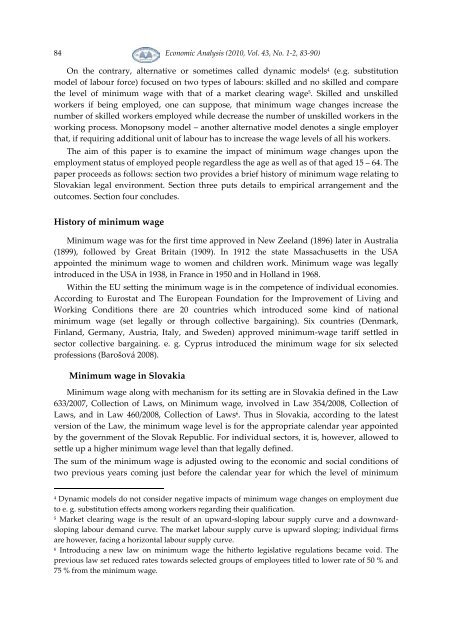Twice a Year Scientific Journal
Twice a Year Scientific Journal
Twice a Year Scientific Journal
Create successful ePaper yourself
Turn your PDF publications into a flip-book with our unique Google optimized e-Paper software.
84<br />
Economic Analysis (2010, Vol. 43, No. 1-2, 83-90)<br />
On the contrary, alternative or sometimes called dynamic models 4 (e.g. substitution<br />
model of labour force) focused on two types of labours: skilled and no skilled and compare<br />
the level of minimum wage with that of a market clearing wage 5 . Skilled and unskilled<br />
workers if being employed, one can suppose, that minimum wage changes increase the<br />
number of skilled workers employed while decrease the number of unskilled workers in the<br />
working process. Monopsony model – another alternative model denotes a single employer<br />
that, if requiring additional unit of labour has to increase the wage levels of all his workers.<br />
The aim of this paper is to examine the impact of minimum wage changes upon the<br />
employment status of employed people regardless the age as well as of that aged 15 – 64. The<br />
paper proceeds as follows: section two provides a brief history of minimum wage relating to<br />
Slovakian legal environment. Section three puts details to empirical arrangement and the<br />
outcomes. Section four concludes.<br />
History of minimum wage<br />
Minimum wage was for the first time approved in New Zeeland (1896) later in Australia<br />
(1899), followed by Great Britain (1909). In 1912 the state Massachusetts in the USA<br />
appointed the minimum wage to women and children work. Minimum wage was legally<br />
introduced in the USA in 1938, in France in 1950 and in Holland in 1968.<br />
Within the EU setting the minimum wage is in the competence of individual economies.<br />
According to Eurostat and The European Foundation for the Improvement of Living and<br />
Working Conditions there are 20 countries which introduced some kind of national<br />
minimum wage (set legally or through collective bargaining). Six countries (Denmark,<br />
Finland, Germany, Austria, Italy, and Sweden) approved minimum-wage tariff settled in<br />
sector collective bargaining. e. g. Cyprus introduced the minimum wage for six selected<br />
professions (Barošová 2008).<br />
Minimum wage in Slovakia<br />
Minimum wage along with mechanism for its setting are in Slovakia defined in the Law<br />
633/2007, Collection of Laws, on Minimum wage, involved in Law 354/2008, Collection of<br />
Laws, and in Law 460/2008, Collection of Laws 6 . Thus in Slovakia, according to the latest<br />
version of the Law, the minimum wage level is for the appropriate calendar year appointed<br />
by the government of the Slovak Republic. For individual sectors, it is, however, allowed to<br />
settle up a higher minimum wage level than that legally defined.<br />
The sum of the minimum wage is adjusted owing to the economic and social conditions of<br />
two previous years coming just before the calendar year for which the level of minimum<br />
4<br />
Dynamic models do not consider negative impacts of minimum wage changes on employment due<br />
to e. g. substitution effects among workers regarding their qualification.<br />
5<br />
Market clearing wage is the result of an upward-sloping labour supply curve and a downwardsloping<br />
labour demand curve. The market labour supply curve is upward sloping; individual firms<br />
are however, facing a horizontal labour supply curve.<br />
6<br />
Introducing a new law on minimum wage the hitherto legislative regulations became void. The<br />
previous law set reduced rates towards selected groups of employees titled to lower rate of 50 % and<br />
75 % from the minimum wage.
















